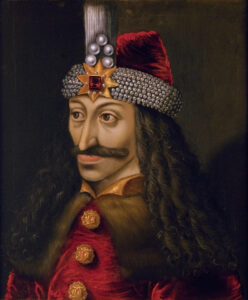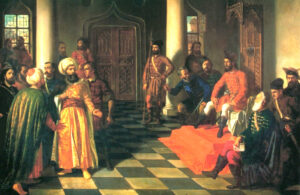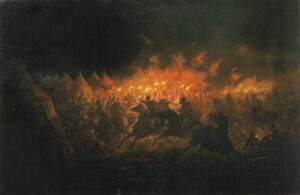
Guerrillas in the Mist of Targoviste
Even the best laid plans for an assassination can go awry, as one of the most famous military commanders of the Middle Ages, Vlad III, realized when he attempted to cut off the Ottoman Empire at the head.

The Night Attack at Targoviste came at the end of a particularly violent struggle between the Voivode of Wallachia and the Ottoman Empire . Vlad’s childhood had been shaped by the time in which he was held as a hostage by the Ottoman Empire with his younger brother Radu. He was educated and learned to speak fluent Turkish. The Ottomans sent him back to Wallachia after the death of his father, but Vlad did not remain loyal to the Ottomans.
In 1461, Vlad refused to pay off the debt owed from accumulated jizya, and flatly refused to contribute 1000 young boys to Janissary training. The sultan, Mehmed II, summoned him to account for his actions.
And then Vlad learned that the Sultan’s summons contained a barb – a plan to kidnap him.

Vlad went on the offensive. He ambushed the Sultan’s messenger and killed the entire expedition force. Then he disguised himself in an Ottoman uniform and spoke to the garrison at the Giurgiu fortress in Turkish in order to have the gates opened. Vlad slaughtered everyone in the fortress.
It was the beginning of a campaign of terror across the Balkans.
I have killed peasants men and women, old and young, who lived at Oblucitza and Novoselo where the Danube flows into the sea, up to Rahova, which is located near Chilia, from the lower Danube up to such places as Samovit and Ghighen. We killed 23,884 Turks without counting those whom we burned in homes or the Turks whose heads were cut by our soldiers… Thus, Your Highness, you must know that I have broken the peace with him [Mehmed]. — Vlad III letter to Matthias Corvinus on 11 February 1462
Christian Europe celebrated Vlad’s campaign, but Mehmed was concerned enough to stop his campaign and attempt to deal personally with the uprising. The size of his army varies in different accounts, but he gathered, at the least, 150,000 troops.
The Wallachians could not stand up to an army of that size directly, so Vlad gathered men, women, and children over the age of 12 to fight. He poisoned wells along the Ottoman marching route. He re-routed small rivers in order to create marshes. He sent people carrying infectious diseases into the Ottoman camps, triggering an outbreak fo bubonic plague. He dug pit traps, and then he evacuated his people and their livestock to the mountains.
When Mehmed and his army reached Wallachia, the land was deserted. There were no people, no large animals, and nothing to eat or drink. For seven days the army marched, growing more and more exhausted.
On 17 June 1462, Vlad dressed in a Turkish uniform and infiltrated the camp of Mehmed II. He learned the location of the Sultan’s tent, as well as the information that the Sultan had given a strict rule that no warriors were to leave their tents that night for any reason.

Several times during the night of 17 June, Vlad’s army attacked. They attacked screaming and carrying torches. The results of the Night Attack, which was meant to specifically assassinate the Ottoman Sultan, vary according to who tells the tale. The Papal Legate Niccolo Modrussa did manage to get an account from a veteran of the battle:
…making use of Turkish prisoners, who had been caught at twilight when they were wandering about imprudently, at nightfall Vlad penetrated into the Turkish camp with part of his troops, all the way up to the fortifications. And during the entire night he sped like lightning in every direction and caused great slaughter, so much so that, had the other commander to whom he had entrusted his remaining forces been equally brave, or had the Turks not obeyed the repeated orders from the sultan not to abandon their garrisons, the Wallachians undoubtedly would have gained the greatest and most brilliant victory… Vlad carried out an incredible massacre without losing many men in such a major encounter, though many were wounded. He abandoned the enemy camp before daybreak and returned to the same mountain from which he had come. No one dared pursue him, since he had caused such terror and turmoil. I learned by questioning those who had participated in this battle that the sultan lost all confidence in the situation. During the night the sultan abandoned the camp and fled in a shameful manner. And he would have continued to this way, had he not been reprimanded by his friends and brought back, almost against his will. –Wallachian battle veteran to Papal Legate Niccolo Modrussa in Budapest
Mehmed II continued on to the city of Targoviste, and it was there that he witnessed Vlad III’s most infamous act – the one that earned him the nickname “Vlad the Impaler”. Outside the city, more than 20,000 Turks were impaled on standing stakes.
The Sultan’s army entered into the area of impalements, which was 17 stades long and seven stades wide. There were large stakes there on which, as it was said, about 20,000 men, women, and children had been spitted, quite a sight for the Turks and the Sultan himself. The Sultan was seized with amazement and said that it was not possible to deprive of his country a man who had done such great deeds, who had such a diabolical understanding of how to govern his realm and its people. And he said that a man who had done such things was worth much. The rest of the Turks were dumbfounded when they saw the multitude of men on the stakes. There were infants, too, affixed to their mothers o the stakes, and birds had made their nests in their entrails. — The Histories by Laonikos Chalkokondyles
Mehmed claimed victory and withdrew, and Vlad continued to fight. This time the armies were led by his younger half-brother Radu. The armies Vlad begged the Christian world for never came; instead he was seized by the Hungarian King Matthias Corvinus and imprisoned.
The Christian rulers of the Balkans fought each other as much as, or more than, the fought the Ottomans.
To read more about the Middle Ages in the Third World, please click here.
- June 18, 2021
- History

